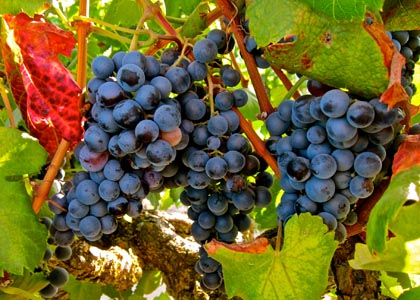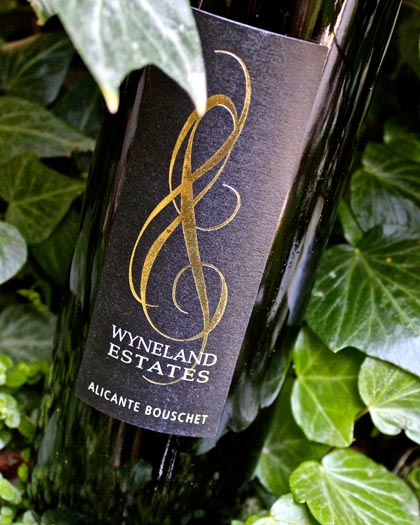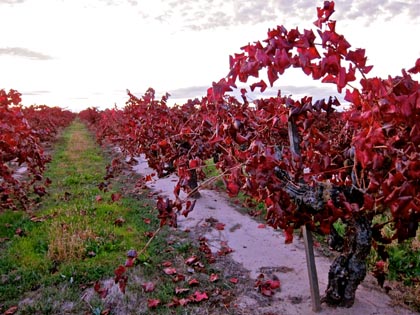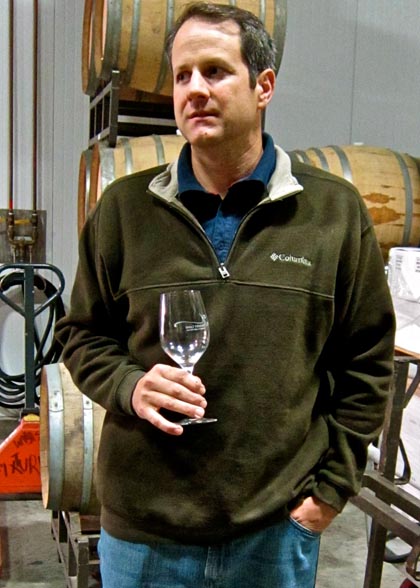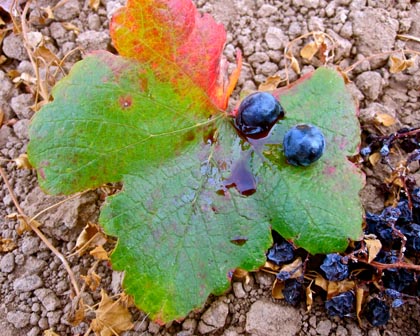Letters from Lodi
An insightful and objective look at viticulture and winemaking from the Lodi
Appellation and the growers and vintners behind these crafts. Told from the
perspective of multi-award winning wine journalist, Randy Caparoso.
Mohr-Fry’s celebrated Alicante Bouschet may soon be kicking up daisies, not gold medals
Mohr-Fry grown Alicante Bouschet grapes
One of the Lodi AVA’s most venerated plantings – Mohr-Fry Ranches’ twelve and a half acres of Alicante Bouschet, which originally went into the ground in 1921 – may not be long for this world, which would be a tragic turn of events.
Especially when you taste the recently released 2009 Harmony Wynelands Lodi Alicante Bouschet ($30), sourced completely from Mohr-Fry Ranches. The ‘09 was this winery’s third vintage to win a gold medal at the San Francisco Chronicle Wine Competition, and for very good reason: it’s a vividly dark red, solid as a Chevy truck, plush and beefy, with a beautiful raiment of aromas suggesting boysenberry, sun dried black cherry, and the little bits of char from the toothsome, caramelized tips of beef ribs when soaked in an exotically sweet soy marinade and grilled. Not just a great wine for food — a wine you can practically eat like a food.
Alas, according to Bruce Fry, Mohr-Fry’s vineyard manager, “we’re sorry to say that our Alicante Bouschet vines are on a short list for the bulldozer, probably within the next year or so – although we will harvest a crop in 2012.”
The problem, says Mr. Fry, is that “the vineyard only produced 1.45 tons per acre in 2011, and 2.37 tons in 2010. To be economically viable, we would have to get over $2,500 per ton with these kinds of yields” – a scenario that is unlikely to happen anytime soon.
But here’s another problem: you cannot replant 91 year old vines. Once it’s gone, it’s gone. There is a possibility, says Fry, that “we might use some of the budwood for a row of two of the newly planted trellised vineyard.” After a few years, those rows might begin to produce even better wine. Who knows? But it won’t be a historic planting – even if they’re still there 90 years from now.
You see, Alicante Bouschet – which old timers in California call al-ee-can-tee (in France, where the grape originated, it is called ah-li-cahn-teh boo-shet – not boo-shay, as commonly believed) – is not nearly as obscure as you may think. In France, it is still the twelfth most widely planted red wine grape in the country, with extensive plantings throughout Provence, the Languedoc and Cognac. The grape itself was originally a cross of two varieties of Vitis Vinifera (Petit Bouschet x Grenache), cultivated in 1866 by a Frenchman named Henri Bouschet (Petit Bouschet itself was another vinifera crossing, created by Bouschet’s father, Louis Bouschet).
Mohr-Fry's Alicante Bouschet in late October
In California Alicante Bouschet had its heyday, not coincidentally, during the Prohibition years of the 1920s. Despite The Volstead Act of 1919, there was a provision left in the federal law called Section 29, which allowed the head of every household to produce up to 200 gallons of wine (or any other fermented fruit juice) per year. 200 gallons, note well, can furnish over two and a half bottles per day – more than enough to keep resourceful American families very happy, and many California grape growers in business, even during the “dry years.”
Alicante Bouschet is a fairly thick skinned grape – its tannin structure is so firm, for years winemakers have used the grape to blend with Zinfandel and even Cabernet Sauvignon to make those sturdy wines even sturdier – and one of the few varieties of Vitis vinifera that is a teinturier: a grape with red pigmented juice (the pulp of most vinifera, such as Zinfandel, Pinot Noir and Chardonnay, is a clear white). Alicante Bouschet became popular during Prohibition precisely because it was hardy enough to withstand the long train rides from California to the East Coast. In New York City there was an auction house set up right in Penn Station just for winemakers and bootleggers, bidding for grapes as they were coming in.
Chad Joseph
It is said that by the 1930s Alicante Bouschet was the second most widely planted wine grape in California; over 40,000 acres of it in Lodi, the Foothills, in Napa Valley and throughout Sonoma. Once Prohibition ended in 1933, and the wine production industry began its slow recovery, the need for a grape prized more for its durability quickly faded; and today, less than 1,000 acres of California’s total wine grapes (about 476,000 acres) are planted to aleecantee.
For Chad Joseph, the widely respected consulting winemaker for Harmony Wynelands, Alicante Bouschet represents something special because it was actually the first wine he made after leaving E. & J. Gallo in 2001, and coming to Lodi. Joseph got his grapes from Kevin Delu’s Bella Vigna Vineyards, and bottled it with a partner under the now-defunct Joseph Narcizo label.
That first wine, says Joseph, “was the funnest batch of wine I have ever made. We had no preconceived notion of what a ‘great’ Alicante Bouschet should be. We got the grapes fermenting and then pressed it half-way through fermentation. Then after a quick settling period, we put it into barrels and let it finish primary fermentation and malolactic fermentation on its own. I never worried about trying to get the color out of the skins, due to the natural intensity found in the juice. The wine was so fruity and complex from the barrel fermentation, and it really developed nicely.
“I continued to make Alicante Bouschet in similar fashion later, for Bob Hartzell (owner of Harmony Wynelands), who really liked the wine we made in 2001. For Harmony Wynelands, we try to get more of a ‘Rhône’ expression from the grape – meaning, more elegant, brighter fruit, and finer textures. 2009 was a great year for Alicante – we let it hang and harvested based off optimum flavor, Brix (i.e. sugar reading) and acid – whereas the last two vintages were more of a challenge. We didn’t do an Alicante in 2010 or 2011. We did harvest a little in 2011, but that was for blending in the GMA (Harmony Wynelands’ Grenache/Mourvèdre/Alicante Bouschet blend) program.”
In October of each year, one of the most spectacular sights in all of Lodi can be viewed right along West Lane, just south of the town of Lodi, where the Mohr-Fry Alicante Bouschet turns into a solid sea of crimson colors – the twisting, gnarly “bush” vines, gleaming like fires in the sun. But it is this yearly show of color that is also the bane of this grape, since the flaming colors and telltale downward rolling of the leaves are also symptomatic of the variety’s tendency towards a pesky disease called leafroll virus, which can stunt growth before grapes reach optimal ripening – extremely problematic in cooler vintages like 2010 and 2011, when sugars are slower to rise, and intermittent rains (as in October 2011) can lead to bunch rot.
The Fry family’s plan to pull up their head trained Alicante Bouschet – one of the largest single circa-1920s plantings of this colorful grape remaining in the state – is understandable. Sustainability in grape growing is as much about economic viability as it is about long term health of vines. We may not be talking about a Château Lafite; but then again, for Alicante Bouschet, Mohr-Fry practically is California’s Lafite. As it is, there are so few varietal bottlings of Alicante Bouschet even made; and among those produced in recent years, those of Mohr-Fry have undoubtedly been the richest, finest, deepest and wildest of them all.
But for nevermore? Let us hope this does not come to pass after all.
The red pigmented pulp of Alicante Bouschet grapes
